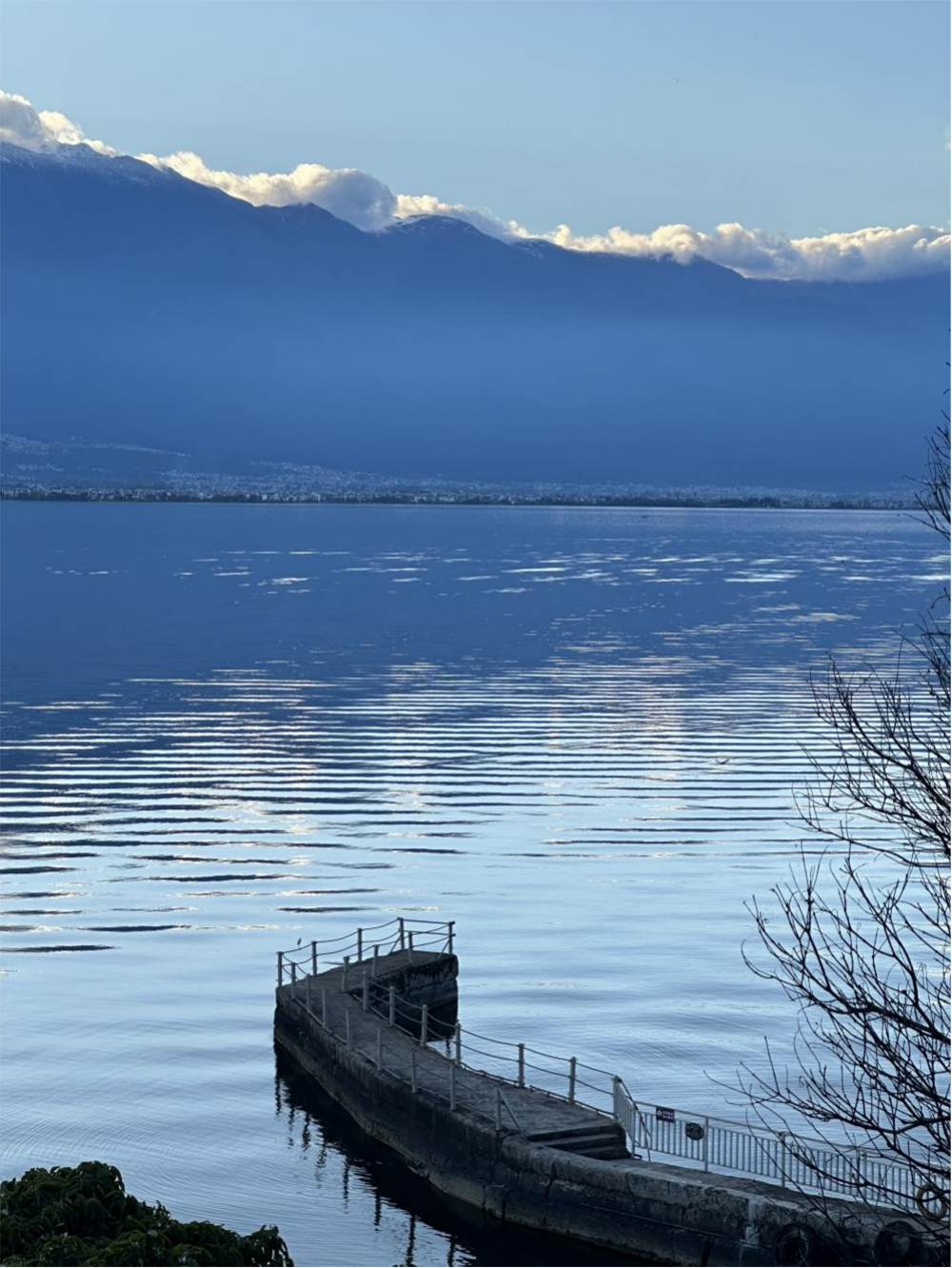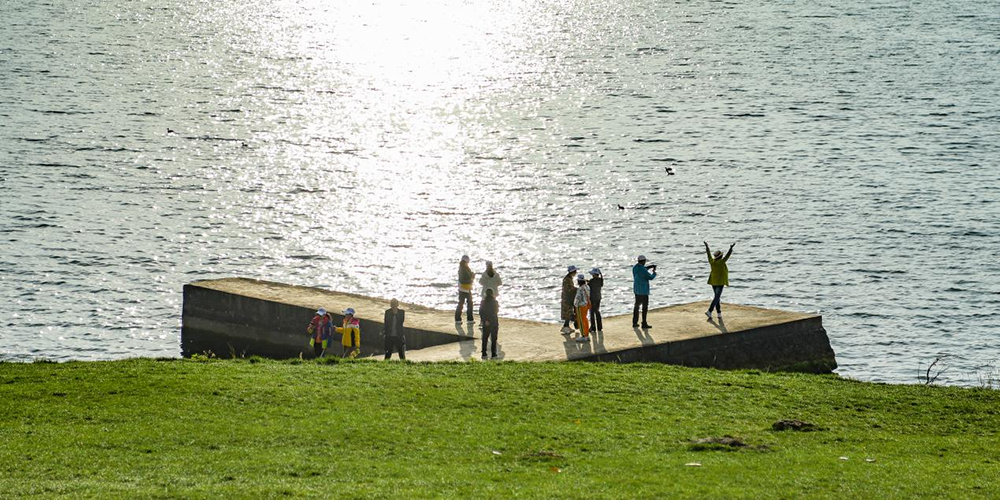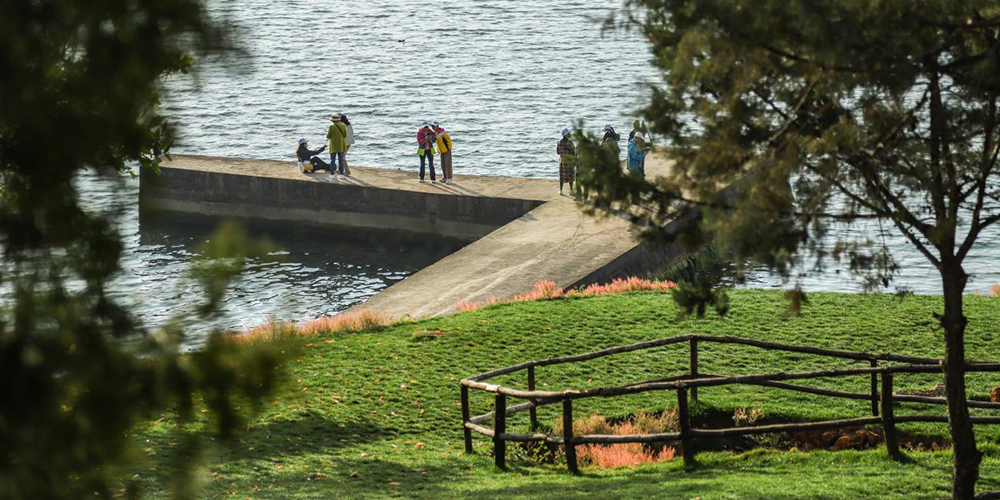Luoquan Ancient Ferry
Li Yuanyang's poem "Twenty-Four Rhymes on a Trip to Erhai Lake" from the Ming Dynasty contains the lines "A single sail flies across the ancient ferry, a single leaf arrives at Luocuan." Xu Danshan's poem "Luocuan Temple" from the Qing Dynasty also has the lines "Frequently beating the oars with the wind, a single leaf arrives at Luocuan." Ancient poems and writings have long confirmed the existence of the ancient Luocuan ferry.
Keyword:
Dali Luoquan
Luoquan Peninsula
Luoquan Pagoda
Tianjing Pavilion
Category:
Spot Description
Li Yuanyang's poem "Twenty-Four Rhymes on a Trip to Erhai Lake" from the Ming Dynasty includes the lines "A sail flies across the ancient ferry, a single leaf reaches Luoquan." Xu Danshan's poem "Luoquan Temple" from the Qing Dynasty also has the lines "Frequently beating the oars with the wind, a single leaf reaches Luoquan." Ancient poems and writings have long confirmed the existence of the ancient Luoquan ferry.
The Luoquan Peninsula is located at the narrowest point between the east and west banks of Erhai Lake, making the ancient Luoquan ferry an inevitable key point on the branch of the Southern Silk Road.
The explanation of the allusion "Han Xi Lou Chuan" is that when the Han envoy was blocked on the east bank of Erhai Lake while seeking the "Shu Shen Du Dao," Emperor Wu of Han ordered the construction of "Kunming Pool" in Chang'an to train the navy. Sima Xiangru ascended the Jade Case to observe Erhai Lake and submitted a memorial to clear the way to Yizhou. Inscriptions on Er Rock such as "This water can support an army of 100,000, while in the past there were only 3,000 guests" and other historical materials all indicate that there must have been a crucial ferry on the Luoquan Peninsula. Ge Luo Feng bestowed the east cliff land to Luoquan for building a temple and giving lectures. Taihe City and Yangju Mie City were both located on the west side of the lake, facing the Luoquan Peninsula across the lake. Without a ferry, this is clearly inconceivable. Zhao Lu's "On Bai Nationality Mythology and Esoteric Buddhism" states that "the location of Luoquan Temple is right at the crucial point on the east bank of Erhai Lake," which is indeed true.
Nowadays, people refer to the ancient channel from the inland areas of Central China to Chengdu, and then from Chengdu via Xichang in Sichuan, Dali and Baoshan in Yunnan to Southeast Asia, which is the "Shu Shen Du Dao," as the "Southern Silk Road".
Some believe that the "Southern Silk Road" is better referred to as the "Shell Currency Road," stating that seashells from Southeast Asia and South Asia flowed into Yunnan in large quantities from early times, serving as the main legal currency in Yunnan from the Spring and Autumn to the Ming and Qing Dynasties for over two thousand years, until the "abolition of shells and adoption of money." Actually, what it's called is not important; what matters is understanding the existence of the road and the geographical conditions of its interconnected paths. A well-connected road facilitates all aspects of communication, including economic trade and cultural exchange. The Southern Silk Road tightly connected Central China with the Southwest Yi people, and through the Southwest Yi people, it connected with Southeast Asia and South Asia. The long history of China's southwestern minority groups, such as the Bai people, and their early proximity to the productivity level and culture of the Han people, are attributable to the opening of the Southern Silk Road. The Silk Road was not only an economic trade route but also a cultural exchange route.
According to relevant historical materials, this Southern Silk Road was at least a hundred years older than the Northwest Silk Road leading to the Western Regions. The northern section of the Southwest Silk Road, from Sichuan into Yunnan, mainly had two routes: one was the "Lingguan Dao," from Chengdu to Yuehe (ancient name Lingguan, near present-day Xichang), to Yao'an, then into central Yunnan, to western Yunnan, or directly to western Yunnan, connecting with the Bonan Ancient Road to Southeast Asia; the other was the "Zhu Ti Dao," from Chengdu to Yibin, entering Yunnan to Zhaotong (ancient name Zhu Ti), then to Kunming, and then to central Yunnan, meeting with the Lingguan Dao, then to western Yunnan, connecting with the Bonan Ancient Road to Southeast Asia. The Bonan Ancient Road, the southern section of the Southwest Silk Road, refers to the ancient road from the junction of the Lingguan Dao and Zhu Ti Dao in central Yunnan via Yunnan Station to Xiaguan, then to Yongping (ancient name Bonan), to Baoshan or Tengchong, Dehong, etc., and then directly to Myanmar, India, and Southeast Asia. There are also historical records stating that the ancient road from Simao, Pu'er via Lincang, Fengqing to Dali, then north to Lijiang to Tibet, is the "Diancang Tea-Horse Ancient Road." The Tea-Horse Ancient Road and the Southern Silk Road meet in Dali, hence the saying "All ancient roads lead to Dali." This is not surprising during the Nanzhao and Dali Kingdom eras, when Dali was the political, economic, and cultural center of Yunnan, and even before that, during the Qin, Han, Three Kingdoms, Western Jin, and Northern and Southern Dynasties periods.
Historical materials show that Dali could be reached directly from Dayao via Xiangyun and Binchuan. In the 17th year of Emperor Wen of Sui's Kaihuang reign (587 AD), after surrendering and being appointed governor of Kunzhou (present-day Kunming), Cuan Wan rebelled. At that time, Dali belonged to Kunzhou, and Emperor Wen of Sui sent Shi Wansui, the general of the Left Leading Army, to quell the rebellion, fighting all the way from Sichuan to Xizhou on the west bank of Erhai Lake. Xu Jiarui's "History of Ancient Dali Culture" suggests that "Shi Wansui went from Dayao via Xiangyun and Binchuan to Dali." The "History of Ancient Dali Culture" also has a special chapter on "The Importance of Dayao in Han Dynasty Military Transportation," quoting "Fangyu Shenglan" as saying: "The ancient Qingxi Pass was excavated by Wei Gao to maintain good relations with Nanzhao. From there, going out of Qiongdou, via Yaozhou and into Yunnan, it is called the Southern Route, and was a key town in the Tang Dynasty." Then it discusses that "In the Tang Dynasty, Yaozhou was an important transportation route between Nanzhao and Chengdu; not only that, but in the Han Dynasty, Yaozhou was also an important route to Dian Kunming." The Kunming of the Han Dynasty refers to Dali, not present-day Kunming. Historical books such as "Records of the Grand Historian," "Book of Han," "New Book of Tang," "Taiping Huan Yu Ji," and "Tong Dian" all clearly state that Kunming originally referred to the people living in the area of the Xier River. The Kunming of the Han Dynasty was in the Ye Yu River (Xier River). "In the Han Dynasty, Yaozhou was also an important route to Dian Kunming" should undoubtedly be understood as Yaozhou in the Han Dynasty being an important route to Dali.
Regarding Zhuge Liang's Southern Campaign, many scholars believe that Kongming did not personally reach western Yunnan, only reaching Qujing and Kaiyuan in eastern Yunnan to subdue Meng Huo before returning to Chengdu. However, the classic historical novel "Romance of the Three Kingdoms," known for its "seven truths and three falsehoods," depicts the seven captures and releases of Meng Huo as involving western Yunnan, mentioning the Xier River. The "Yunnan Tongzhi" and the Ming dynasty notes "Sanyi Suibi" both claim that Fuguangzhai (near Sanying Township, Eryuan County) was where Kongming captured Meng Huo. Li Hao's "Sanyi Suibi" also mentions that Zhuge Liang's Southern Campaign divided its forces into three routes, with the main force led by himself from Chengdu to Yuewei (Xichang, Sichuan), traveling through Liangshan to Yongsheng, Yunnan, crossing the Jinchuan Ferry (a ferry crossing on the Jinsha River), and capturing and releasing Meng Huo several times at places like Chishiya (Pingchuan, Binchuan County), Gudi Village (Gudi Township, Binchuan County), Xierhe Tianshengguan (near Xiaguan), and Fuguangzhai. He is said to have stationed troops in Shihe City (Xiaguan) and at the foot of Diancang Mountain, made an alliance with Meng Huo at Tiezhushan (琵琶山, Pipa Mountain, Beiyaxia, Heqing County), then turned east towards Yaozhou, and returned to Chengdu via the Qingling (Yongren, Dayao area) route. Li Hao, the official appointed as the Zhenfu envoy of the Tianwei Jing (in Xiaguan) under the Yunnan General's Office of the Ming Dynasty, even wrote that it took Zhuge Liang 46 days to reach Ye Yu, and that he himself "in the early Yongle years, searching for Zhuge Liang's campaign route, reached Chengdu in 42 days, a truly swift route." Local folklore in Haidong also claims that Zhuge Liang's Southern Campaign reached Haidong. There is an ancient village in Haidong called Mingzhuang. The three brothers Meng Huo, Meng You, and Meng Jie are the local deities of this village. Legend has it that Mingzhuang was originally where Meng Huo stationed his troops. The "Haidong Zhi" of the Republic of China period has a specific entry on "Meng Huo Village," stating that "the village is at the foot of Feifeng Mountain in Mingzhuang, and there is a Meng Huo temple." In the northwest corner of Mingzhuang, about seven or eight li away, at the foot of Yu'an Mountain, there is a wide mountain valley, commonly known as "Daping and Xiaoping," which is said to be where Zhuge Liang stationed his troops. Haidong is not far from Chishiya, Gudi Village, Fuguangzhai, and Tianshengguan, and there are roads connecting them. The place where Zhuge Liang stationed his troops and the Luozhuan Peninsula both belong to Yu'an Mountain, one on the east slope and the other on the west slope, not far apart. The exact route of Zhuge Liang's Southern Campaign remains inconclusive, and we cannot delve deeper into it. However, we can confirm that the ancient passage from Yaozhou to Dali was a crucial military and transportation route during the Han and Tang dynasties. The northern section of the Southwest Silk Road, the Lingguan Road, could bypass central Yunnan and directly reach western Yunnan, and important branch roads were possible.
The war between Nanzhao and the Tang Dynasty during the Tianbao era began with the struggle for Yaozhou. The "Yaozhou Incident" in 750, where Ge Luofeng killed Zhang Qiantuo, was the trigger for the Tianbao War. The Tang Dynasty established the Yaozhou Dudufu to govern the various vassal states in western Yunnan. From Yaozhou, one could travel via Xiangyun to Binchuan (or Zhaozhou) and then to Dali, or via Yongsheng to Binchuan and then to Dali, but to enter the ancient city, one had to cross the Xier River. The "Southwest Silk Road" not only had post stations and passes but also ferry crossings. In fact, the "Du Lancang Song" circulating during the Eastern Han Dynasty already indicated the existence of ferry crossings on the Bonan ancient road. In the line "Han Deguang, opened Bubin, crossed Bonan, crossed Lanzin, crossed Lancang, for others," "Lanzin" refers to a ferry crossing, indicating the need to cross water. The Jinsha River also had ferry crossings; even without boats, bamboo rafts or other water transport tools were necessary. Ferry crossings were not arbitrarily chosen; they depended on the water conditions and terrain. Before the completion of the Huanhai Road, the east bank of Erhai Lake was not passable everywhere; many sections were cliffs and could not be traversed, and it was not possible to simply stop a boat and land. In 648, during the Tang Dynasty's Zhenguan 22nd year, after the campaign against the Song Wai Man reached the Xier River and the envoy successfully persuaded the He Man leader Yang Lian to surrender and "returned victorious," You Wu General Liang Jianfang, who wrote the "Xierhe Fengtu Ji," described the area at that time as "having boats but no carriages." Before the construction of roads, "having boats but no carriages" was indeed a characteristic of transportation in the mountainous and watery Erhai Lake region. With many mountains and rugged roads, only horses and walking were suitable; the vast Erhai Lake required boats for travel. Ferry crossings were extremely important. Nanzhao, relying on the natural defenses of Cang'er, established its capital city on the west side of the lake, first Taihe, then Dali (Xizhou), and Yang Jumei, building upper and lower passes. To protect against water attacks, the Nanzhao king also built the Sheli Water City on Jinsuo Island in the east of the lake. This was not entirely for summer retreat but also for defense. Furthermore, the king had the most capable Buddhist monk, Luozhuan, build a temple on the east cliff to preach and teach 800 disciples. This also served a defensive purpose. It is said that the Nanzhao king had people engrave "The National Gate is Here" on the reefs in the lake in front of Yu'an Mountain. "National Gate" refers to the main gate of the capital. This can also be seen as evidence of the Nanzhao king's reliance on natural defenses and emphasis on water defenses. "Huai City Night Talk" records: "In the early Jiajing period, a fisherman found a box of eight copper seals on Yu'an Mountain, which were identified as military seals of He Liguang. He Liguang stationed troops on Yu'an Mountain and buried the seals in the ground. After verification, they were stored in the Zhaozhou government treasury." "Sanyi Suibi" records that during the Yuan Dynasty's conquest of Dali, the last emperor of the Dali Kingdom, Duan Xingzhi, "took his concubines and ministers, boarded boats on the east side of the river, and took the Baiya (now Hongya) route to escape to Shanan (now Kunming)." He was later captured and surrendered to the Yuan Dynasty, inheriting the title of "Dali General Manager." In 1382, during the Ming Dynasty's Hongwu 15th year, when the Ming Dynasty attacked Dali, the last Dali General Manager, "Duan Shiming, unprepared, took his family and crossed the river to the east." Li Wenrong's "Binyang Zhi Shu" states that "before the establishment of Binchuan, Haidong was the eastern border of Dali; after the establishment of Binchuan, Haidong became the western border of Binyang. During the Tang Dynasty's conquest of Nanzhao, the upper and lower passes were impassable, and only the Haidong sailing ships could control the key points to facilitate a swift conquest of the west." His "Interview with Haidong Zhi Ba" also states that "during the Tang Dynasty's conquest of Nanzhao and the Qing Dynasty's conquest of Du Qiu (referring to Du Wenxiu), they all sought to cross the east to provide reinforcements." All of this shows that Haidong was a crucial military and transportation hub, and the importance of ferry crossings cannot be overlooked.
Haidong was located within the directly administered area of the capital city during both the Nanzhao and Dali Kingdom periods. During the Nanzhao period, it belonged to Yang Prefecture among the Ten Prefectures, and during the Dali Kingdom period, it was part of Hedong Prefecture in the imperial capital. During the Yuan Dynasty, it was directly under the jurisdiction of Dali Road, and during the Ming Dynasty, it belonged to Taihe County, Dali Prefecture. It was only incorporated into Binchuan after the seventh year of Hongzhi in the Ming Dynasty. In the mid-1950s, it was again incorporated into Dali City. Haidong is separated from the ancient city of Dali only by a body of water. Without boats, Erhai Lake is a natural barrier; with boats, there is daily travel, and water transportation is very convenient. Southeast from Haidong, via Fengyi and Xiaguan, one can reach the ancient Bonan Road, and further travel to Midu, Weishan, Nanjian, and Jingdong, leading to the ancient Tea Horse Road, extending far to Vietnam. Alternatively, one can travel via Lincang and Gengma to Myanmar, Thailand, and Laos. Eastward, via Binchuan and Xiangyun, one can reach Lingguan Road, or from Binchuan to Yongsheng and then to Sichuan. Northward, via Dengchuan, Eryuan, Heqing, Lijiang, and Diqing, one can reach Tibet. When Haidong belonged to Binchuan, it was in the same southern district as Paicamp (Lingshan Town) to the east, separated by thirty li (approximately 15 kilometers), with frequent interactions. Paicamp, anciently known as Mouhanchuan, is said to have been named after the camps set up by Mu Ying and others during their southern campaign in the Ming Dynasty. From Paicamp, one can go south to Binchuan and then to Xiangyun; east to Niujing, Pingchuan, and then to Yongsheng; and north to Daying, Cun, Heqing, and Lijiang. For Haidong people, going east to Paicamp and west across Erhai Lake, leaving early and returning late, has become a custom. Before the advent of roads, transportation relied on pack animals. During the Ming and Qing dynasties, Haidong also had many large mule trains engaged in transportation, with every village having its pack animal handlers. Yang Gaoming, a native of Wenqu Village in Haidong during the Qing Dynasty, was a famous leader of a large mule train. It is said that his mule train often traveled to Kunming and Tengyue, sometimes even going abroad to Myanmar and Thailand, with over a hundred horses and mules. Legend has it that he donated two loads of silver to the construction of a large bridge in Lufeng.
The "Manshu" (written by Fan Chao during the Tang Dynasty), hailed as "a great dictionary concerning the ancient ethnic groups and geography of Yunnan," records: "The Nangcong Mountain is located east of the Xier River...facing Binchuan and Yuexi. There is a road at the foot of the mountain, leading from Qulian Zhao to Dengchuan." Nangcong Mountain is the present-day Daqing Mountain, east of Shangdeng and Shanghe in Haidong Town, forming the boundary between Binchuan and Haidong. The Yongzheng "Binchuan Prefecture Records" states that Nangcong Mountain is seventy li (approximately 35 kilometers) away from Binchuan. An existing ancient tombstone at the foot of Daqing Mountain has a couplet that reads: "Jade Erhai and Silver Cangshan condense auspicious mist, Nangcong iron peaks give rise to humanity," further indicating that Daqing Mountain in Haidong is indeed Nangcong Mountain. "Qulian Zhao," according to "Manshu," refers to "Hedong Prefecture," indicating the Fengyi area of Haidong. "Dengchuan" refers to Dengchuan. "Manshu's" description of Nangcong Mountain specifically mentions a road leading to Dengchuan, highlighting an important ancient passageway in Haidong. This passageway is actually a branch of the Southern Silk Road and the Dian-Zang Tea Horse Road, which after converging in central Yunnan, heads north along the east of the Erhai Lake (referring to the east of the Erhai Lake). This branch does not cross the Xier River, running parallel to the Tea Horse Road that crosses the Xier River and passes through the ancient city of Dali, converging with it after reaching Dengchuan. Wang Fu's "Lu Chuan Zhi Gao" states: "Haidong was the Dong'er River during the Tang Dynasty, also called Hedong Prefecture. The residents here were called 'Dong'er River barbarians,' belonging to the same ethnic group as the 'Xier River barbarians,' collectively known as 'He barbarians,' the ancestors of today's Bai people. This was an ancient transportation hub, more convenient than the route via the Xier River, serving as a vital route connecting Yunnan (Xiangyun), Baiya (Midu), Shihe (Fengyi), and Yuexi (Binchuan) to Dengchuan, Langqiong (Eryuan), Yanggong (Heqing), and Jianlang (Jianchuan." This confirms the importance of this north-south passageway in Haidong. Several historical records corroborate this. According to relevant entries in "Dali Ancient Lost Books," during the Tianbao War, Nanzhao sought aid from Tubo, and the Tubo troops stationed in Langqiong cut off the Tang army's retreat by taking this route. When Duan Siping launched his rebellion against Dayining Kingdom, as Longwei Pass was difficult to take, he divided his troops, sending half of them north from Haidong to Longshou Pass and then to Jiangwei Ferry, successfully entering Yangjuma City. During the Yuan and Ming dynasties' attacks on Dali, troops were also dispatched via Haidong.
Going north from the foot of Nangcong Mountain, passing Zunzhuang Yakou (mountain pass), about four or five li (approximately 2-2.5 kilometers), there is a small hill at the junction of Wenwu, Shangdeng, and Nancun, near Nanqichang Qiong (a ravine). The hill resembles an upside-down gourd, locally known as the beggar's gourd. Its side is traditionally called Tangyuan Street, where passersby and mule trains often rested, named after someone who sold tangyuan (glutinous rice balls). West of Tangyuan Street, there is a passageway to Nancun and Nanqichang leading to Xiaguan; east to Paicamp, Niujing, and Binchuan; and north to Haidong, Wase, Dengchuan, Eryuan, Heqing, and Lijiang. The ravine has water, and the surrounding terrain is relatively flat, making it a convenient resting place for passersby and mule trains, thus forming "Tangyuan Street." "Tangyuan Street" remains a topic of conversation among people in their seventies and eighties. This is further evidence of the importance of the north-south passageway in Haidong.
The Lingguan Road, a southwest silk road from Dayao via Xiangyun and Binchuan, meets the Hedong branch of the Dian-Zang Tea Horse Road in Haidong. From the ferry crossing, one can cross Erhai Lake and reach the ancient city of Dali directly.
Luoquan Ancient Ferry, located on the east bank of the narrowest part of Erhai Lake, provides convenient access to the western Longkan Ancient Ferry and Caicun Ancient Ferry, and also serves as a convenient transfer point for nearby ferries such as Haidong Tatao Ferry, Foutou Ferry (Xiangyang Ferry), Wenbi Ferry, and Jinsuo Island, as well as for boats traveling north and south. Luoquan Temple thus became an important station before Jizu Mountain, serving as a crucial stop for people crossing Erhai Lake to worship at Jizu Mountain. Undoubtedly, Luoquan Ancient Ferry was a key point on the branch of the Southern Silk Road, a fact supported by historical evidence. The Ming Dynasty inscription "Qixi Pan Er Ge Ci Yun" by Zhang Ruishen on the cliff overlooking the sea next to Luoquan Ancient Ferry contains the line "South to Jiaozhi, North to Youyan," which serves as strong evidence.
With the advancement of the times, the newly built pier on Luquan Peninsula has replaced the ancient ferry crossing. Now, only fishing boats or small yachts occasionally dock at Luquan Ancient Ferry. Larger and smaller boats of various types, unable to adapt, now dock at the newly built pier on the northwest side of Luquan Peninsula, not far from the ancient ferry. The new pier has a relatively sheltered harbor, with multiple mooring points for boats. The new pier can accommodate four large yachts and dozens of other boats simultaneously. A gate and screen wall, built in the style of Bai architecture, have also been constructed on the pier. The pier gate serves as the water entrance to the scenic area, facing west towards Erhai Lake. A couplet on the gate reads: "Erhai Lake, truly a sea, vast and misty, with magnificent scenery, a grand view that broadens the mind; A celestial mirror, a wondrous sight, beautiful mountains and waters, boundless scenery, reaching a fairyland, worries surely disappear." After disembarking and entering the scenic area through the pier gate, tourists can walk south along the shore, following the newly built path at the foot of the cliffs where "Stone Cave Fishermen" once lived, to "Er Rock Inscription." Continuing south for a few dozen meters, they will reach the 73 stone steps leading to Guanyin Pavilion and Baxian Tower. Climbing the steps, they can enjoy a pleasant journey through Luquan Peninsula.
Recommended Attractions
Wind, Flower, Snow, Moon Pavilion
The First Pavilion of Erhai Lake - Tianjing Pavilion








